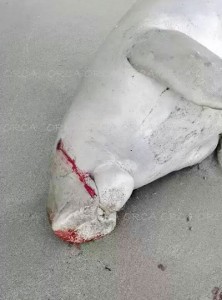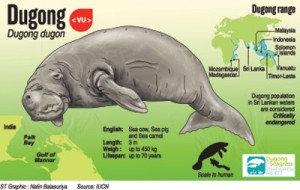News
Threatened dugongs thrown a lifeline
The dugong is the most threatened marine mammal likely to disappear from our waters, but there are efforts to save the species.
Thirteen dugongs were killed last year, according an informal survey in the North Western coastal areas by marine activists. This is one dugong killed every month and considering their rarity, is worrying, says Prasanna Weerakkody of Ocean Resources Conservation Association.

A dugong washed ashore on Nadukuda beach in December, 2016. Pic courtesy Ocean Resources Conservation Association
The latest dugong deaths occurred December last year. A carcass was found on Nadukuda beach in Mannar. A few weeks earlier, another carcass washed ashore near Thavilpadu beach. Fishing activities using explosives are common in the nearby Vankalai Coral Reef and marine activists initially thought dynamite had killed the dugong found in Nadukuda.
‚ÄúThrough informal discussions with fishermen, we found out that one dugong had been trapped in a net. The fishermen knew it was illegal to pull it ashore and had it anchored under water to collect it when the navy is not around. But the carcass got loose and washed ashore,‚ÄĚ revealed Weerakkody. There could be many other dugong deaths that go unreported, he said.
Dugongs are also called mermaids of the sea because some sightings of mermaids are actually misidentified dugongs seen from afar
The dugong is also known as the ‚Äėsea cow‚Äô for its habit of grazing on the seagrasses on the ocean bed. Seagrass is different from seaweeds (which is an algae) and are actually more closely related to the flowering plants with roots, stems, leaves, flowers and seeds. Seagrasses can form dense underwater meadows and an adult dugong consumes as much as 45 kg seagrass according to experts.
Dugongs are vulnerable to extinction because they are killed directly or indirectly by human-related activities, which include fishing, coastal development and hunting. The seagrasses on which they depend are thought to be one of the most threatened ecosystems on Earth.
In 2015, the ‚ÄúDugong and Seagrass Conservation Project‚ÄĚ was initiated to improve protection and conservation of dugongs and their seagrass habitats around the world, said United Nation‚Äôs Environment Program (UNEP)‚Äôs Max Zieren who recently visited Sri Lanka. Indonesia, Madagascar, Malaysia, Mozambique, Solomon Islands, Sri Lanka, Timor Leste and Vanuatu is part of the project, which is the first coordinated effort, he added.
In Sri Lanka, the project focuses on the northwest region, namely the Gulf of Mannar and Palk Bay where dugongs have been recorded. The project is coordinated by the Department of Wildlife Conservation and eight other partner organisations are supporting.
Sugath Emmanuel, local fisherman and diver in Kalpitiya, said he had not seen a dugong alive. He recalled eating dugong flesh during his childhood, in an area where many dugongs were caught. The flesh was considered a local delicacy. Hundreds of dugongs were killed before it was outlawed in the 1970s. Now, about 90 percent of the dugong killings are accidental or by-catch.  
Dugongs are categorised as ‚Äėvulnerable‚Äô in IUCN‚Äôs threatened species list considering global populations, but they can be ‚Äėcritically endangered‚Äô in Sri Lankan waters, says Arjan Rajasuriya, project manager of International Union of Conservation of Nature (IUCN). He has been diving for the past 30 years, but has yet to see a dugong alive.
IUCN’s responsibility in the project aims at establishing an additional 10,000 hectares of marine protected area in the Gulf of Mannar and Palk Bay. Rajasuriya says dynamite fishing should be halted.
The project also aims to raise awareness among people and also give incentives to abandon illegal fishing methods. Project partner, Sri Lanka Turtle Conservation Project, is seeking to reduce the negative impact of destructive fishing practices on seagrass habitats and provide income generation opportunities to local communities in return for their commitments for the prudent use of habitat and natural resources in the Puttlam lagoon.
The Biodiversity Education and Research NGO has taken on the education aspect of the project, especially targeting schools. Ranil Nanayakkara, who heads the group, says the response from school children has been positive.
The overall project is financed by Global Environment Fund Project and Mohamed bin Zayed Species Conservation Fund. The United Nations Environment Programme supports its implementation together with the Memorandum of Understanding on the Conservation and Management of Dugongs and their Habitats throughout their Range of the Convention on Migratory Species.
Dr Lakshman Peiris, who is the project manager of DWC, said the Wildlife Department was focused on addressing marine issues with the establishment of a special unit.
The Sunday Times also asked Peiris what will happen after the four-year project ends in 2018. “The project will give us lots of information. We will create a management plan and will make sure its implementation together with other strategic partners such as Department of Fisheries, Coast Conservation & Coastal Resources Management Department, and the Marine Environment Protection Authority. The Sri Lanka Navy and Sri Lanka Coast Guard can give us lots of support by monitoring and stopping illegal activities,’’ Peiris added.
Dugongs are also found in the Indian part of the Gulf of Mannar, but unfortunately India is not part of the project. Marine biologists say India too needs to get on board. Peiris of the DWC said plans are underway to increase coordination between two countries.
Marine biologists also stress the need for action, once a strategy to save the dugongs are made. ‚ÄúSince the dugong is a charismatic species, we can use activities geared to protecting it to also help us to provide a refuge for other threatened marine creatures,‚ÄĚ marine expert Rajasuriya said.
| Experts gather to discuss future of Dugongs  The third Meeting of Signatories to the Memorandum of Understanding on the Conservation of Dugongs and their habitats (Dugong MOU) was held last week in Abu-dhabi. A number of DWC and NARA officials participated at the meeting representing Sri Lanka that signed the Dugong MOU on 2012. IUCN’s Sirenia Specialist Group (dugongs and manatees)’s Sri Lankan representative Ranil Nanayakkara said the gathering provided a good platform to learn about conservation initiatives used by experts in other countries.
|
|

